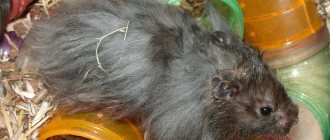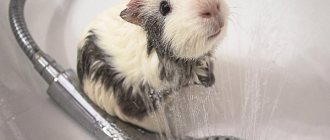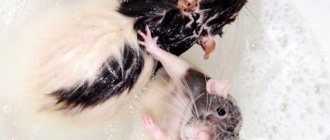The hamster is one of the cutest and friendliest pets. The hilarious behavior of this animal, its funny face and beautiful fur evoke affection in both children and adults.
Those who decide to have a rodent in their home need to study the rules for caring for it in advance. One of the key questions is how to wash a hamster?
Actually, I’m white... Well, that’s how it happened!
Is it possible to bathe a hamster in water?
In most pet stores you can find two breeds of hamsters: Djungarians and Syrians. The rules for caring for them are slightly different, but in general their physiology is similar. Both the former and the latter have natural habitats that are steppes and deserts. Such living conditions have taught small rodents to be very clean; they clean their fur 5–6 times a day, which is why they look neat, even if they are not washed.
Due to their existence in an arid climate, rodents do not tolerate water treatments well:
- Their fur is very thin, making them sensitive to cold water.
- If the water is too hot, your pet may have a heart attack.
- Hamsters can swim, but poorly. Without reaching the bottom, the rodent may panic and drown.
So, back to our question: is it possible to bathe hamsters? It is undesirable to do this, since this is serious stress for the small body of a rodent. However, there is no need for regular bathing, since the animal carefully observes hygiene.
Hamster breeding
Animals become sexually mature very early, within a month from birth. But, provided that you are not in a hurry with breeding, it is still better to let the animal grow up to five months. It is necessary to happen in an area that does not belong to any of the pair of hamsters, so they will be more comfortable. It is best to do this in the late afternoon.
Within a week after the event, if the female was able to become pregnant, her nipples will swell, and after 2-3 weeks the babies will be born
It is important that the male must be separated from the pregnant and lactating female; he can even eat the cubs, and the female becomes overly aggressive, protecting the children
After giving birth, the female should not be disturbed or touched for two weeks. You don't even need to clean the cage. The main thing is to provide her with enough tasty and healthy food. Baby animals can usually be separated from their mother at the age of a month.
In what cases is bathing a rodent justified?
Djungarian and Syrian hamsters are very freedom-loving and need constant physical activity. They cannot be kept in a cage all the time, otherwise they will become unsociable and may start to get sick. Therefore, rodents often run around the house and, when left to their own devices, can get dirty.
One of the most common problems with bathing a hamster is food contamination. The fact is that there is a whole list of substances that can cause allergies or poisoning in your pet. And since he regularly licks his fur, whatever he smeared himself in will certainly end up in his mouth. So, bathing is justified if the hamster gets into:
- Jam.
- Oil.
- Honey.
In general, any sticky and viscous products can be added to this list, since it will not be possible to clean the wool in any way other than washing.
Of course, I'm not a pig, but I will find dirt.
A more dangerous situation is when toxic products get on the animal’s body. Bleach, disinfectants, acetone and other chemicals cause serious damage to fur. And if such substances enter the body when the pet washes itself, it can lead to death.
Another reason to bathe your hamster is heavy contamination of the fur with droppings and urine. But this situation is out of the ordinary and only the owner is to blame for it, who does not sufficiently monitor the conditions in which the pet lives. To avoid this, you need to regularly clean the hamster's cage, wash it, and do not forget to change the bedding.
Hamster care
Keeping and caring for a hamster at home is a simple process, but it requires certain knowledge and care. You can determine whether your animal is feeling well by such signs as shiny fur without bald spots, a clean nose and eyes, even breathing, and the absence of digestive disorders. Since the pet usually sleeps most of the day, it is better to assess its behavior in the late afternoon, during the period of activity.
Cage for a hamster
Caring for and keeping a hamster at home always starts with choosing a good cage. They come in plastic and lattice. Plastic container-like ones are most convenient for dwarf hamsters (Roborovsky, Campbell, and dwarf hamsters). But lattice ones are perfect for golden (or Syrian) breeds. The main thing is that the bars of the cage are placed horizontally so that the animal can climb the walls. The gap between the rods also depends on the specific type - for golden, a distance of 1 centimeter is acceptable, for smaller types - less.
If the distance between the bars of the cage is incorrect, the animal may unsuccessfully stick its head between them and die from suffocation.
The next step in caring for an animal at home is to properly equip its “apartment”. It starts with the choice of bedding - both the comfort of the rodent and the time you will spend cleaning the cage will depend on this. It is advisable not to use newsprint as bedding, otherwise your pet may be poisoned by printing toner. In addition, such paper does not absorb liquids and odors well. However, the same applies to ordinary paper or cotton wool. Cotton wool in a cage is also not recommended because the animal's small paws can get tangled in it.
Fillers such as sawdust, hay or wood shavings are better suited. But some animals are allergic to ready-made wooden pellets. Corn (chopped cobs with a few grains left) is recognized as the best option for filling the cage. It is very light and pleasant for the animal. This filler is more expensive than others, but it retains the smell for up to ten days.
Place two feeders in the cage - one will serve for soft food such as fruit, the other for hard and dry food. And for water it is better to purchase a special drinking bowl, changing the contents every day.
Hamster wheel
Caring for a hamster at home is not complete without providing it with physical activity. To do this, you need to equip the cage with a wheel, and also buy a hamster ball and other accessories (slides, ladders). The wheel must be solid, with transverse protrusions. Then it will be convenient for the animal to place its paws on it.
The rodent will use all this variety in the cage mainly at night, and during the day it will rest in its burrow. A special house can serve as a mink, but sometimes the animal prefers to make its own home by collecting filler or bedding to the side.
Hamster ball
It is worth talking in more detail about such a device as a hamster ball. This is an excellent simulator that will not let the animal get bored. Ready-made balls are sold in stores, or you can make the device yourself. Its purpose is to allow the animal to move freely around the apartment without the risk of being crushed, caught by a cat, or stuck somewhere. A hamster ball will fit especially well in a large apartment or house.
The easiest way to make this accessory is from an ordinary plastic bottle. Due to its lightness, it will not make it difficult for the hamster to move. In addition, you can make holes in it for ventilation. Actually, no other manipulations are required - the hamster ball is ready for use.
You can also take not a bottle, but a plastic ice cream bucket (the main thing is that it is transparent). The bucket must be thoroughly washed and dried, and then small holes must be made in the bottom or lid of the container. Now you can put the hamster inside and close the lid. In a similar way, you can make a ball for a hamster from any container. The stores sell dozens of different beautiful and convenient options.
What to pay attention to before swimming?
To avoid causing physical harm and to avoid severe stress, follow these bathing rules:
- Heat the water to 30 – 35 degrees before washing your hamster. If it is colder, the pet may catch a cold; hot - get a heart attack.
- Be careful not to get water into your eyes or ears.
- Prepare a towel and hairdryer in advance. After the bath, the animal needs to be dried as quickly as possible, otherwise it may get sick.
Important: under no circumstances should you use regular soap or shampoo. A hamster can only be washed with a special detergent sold in pet stores (if you can’t find one for a hamster, buy one for a rabbit or rodent - it’s also suitable). This is due to the fact that the acid-base balance of human and rodent skin is different. Because of this, when using the wrong shampoo, the rodent’s protective fat layer is disrupted, which leads to dermatitis and scratching, in place of which purulent wounds form.
This cannot be used. Buy your hamster a special shampoo.
List of necessary components for washing
A bowl
Washing your hamster in the sink is not the best option. It is better if the animal can rest on its paws and not slide too much. A bath for a hamster is any small, stable container.
Fill the bowl with slightly warm water (slightly above room temperature) to 2 cm.
Available means
If you simply rinse the animal with water, running your hands over the body, it is not enough to clean the fur using a cloth or a soft toothbrush. It is convenient to wipe the face, eyes, and anus with cotton pads.
Shampoo without fragrance
Only for special stains (sticky or toxic substances) use detergent. The pet store may not sell a special shampoo for hamsters, but it’s good if you can buy a detergent for washing rodents or rabbits. It is better not to use human products (even for babies): they are intended for a different skin pH.
Hand towel, pet cloth, paper towels
Delicacy
Food rewards can help reduce stress and keep your pet in your arms long enough to dry him off. Juicy or protein food (piece of chicken, fruit) is usually used as a treat. The animal must like the product.
Assistant
In order to bathe a hamster, two people may be required, this is more convenient. Small nimble animals should not be let out of your hands even for a moment. While the owner holds the rodent, the assistant pours water and gives a towel.
How to bathe hamsters at home?
Let's move on to the instructions on how to bathe hamsters. The recommendations are relevant for both Djungarians and Syrians and other breeds:
- You need to prepare a bowl that will serve as a bath. Some bathe in the sink, but this is not the best option - water can get into the pet's ears or eyes.
- Heat the water to 30 - 35 degrees.
- Place your pet in the container and begin to wash it slowly, pouring warm water over it.
- Apply a special detergent and process the coat, avoiding the ears and eyes.
- Wash the body thoroughly and dry the rodent with a towel or napkin (or better yet, get wet).
While your pet is bathing, maintain a dialogue with him. The sound of a familiar voice will help him endure water procedures more easily. Be prepared for the fact that while washing the animal may start squeaking and biting. In this case, it is better to stop washing and try after a while when it calms down.
And now we’ll tell you in more detail about how to wash the Dzungarian and Syrian.
Don't forget to dry the baby thoroughly.
Features of bathing Djungarian hamsters
Experts do not give a clear answer to the question of whether it is possible to bathe a Djungarian hamster in water. Most veterinarians agree that washing can only be done if the dirt cannot be removed in any other way. Some people believe that bathing is also acceptable if there are parasites in your pet's fur.
The answer to the question of how to wash Djungarian hamsters is given in the instructions above. In addition, let's say that you can only pick up a rodent with your hands. At the same time, this must be done very carefully, since Djungarian hamsters are very sensitive to touch, like any other breed. If you squeeze your pet too hard, you can damage its internal organs.
Bathing a Djungarian hamster, compared to bathing a Syrian hamster, is a simpler procedure. This is due to the following reasons:
- Djungarians react more calmly to being washed. Some of them even like bath treatments.
- They have short fur, which you can quickly and easily dry with a towel or napkin.
- They have better immunity, so catching a cold after swimming is less likely.
I know how to swim, but I don’t want to, honestly.
Features of bathing a Syrian hamster
Syrian hamsters are very finicky and require more care during and after bathing. A few tips to help minimize discomfort for your pet:
- You need to wash your Syrian hamster very quickly. Swimming is not an option for him - he will definitely get sick.
- Upon completion of the procedures, dry the wool with a hairdryer on low setting. Do this only if you are sure that the rodent will not be scared by the noise.
- On the way to the crate, wrap your pet in a towel, even if the fur is dry. This is necessary for his body to warm up to its usual temperature.
Tip: To reduce stress for your pet, use food rewards in the form of treats that he loves. This will help keep it on your hands longer while drying.
I won’t smear myself, I swear by my hamster mother!
Sequence of actions when bathing a Djungarian hamster
We wet the Djungarian hamster
The hamster should be placed on a flat surface, and then water at room temperature should be poured on top. Try not to wet the animal’s head and especially the animal’s ears and nose. It is highly undesirable to wash your pet with tap water in order to avoid unexpected temperature changes. And a slippery sink is not the best place for washing.
Soaping a Djungarian hamster
Shampoo in its pure form is completely unsuitable. Just a drop is enough to be diluted in water. Appear with foam and lather the wool with massaging movements. This is done with your fingers, without using a washcloth or sponge.
Rinsing a Djungarian hamster
After using shampoo, the coat and skin are thoroughly rinsed with water to completely rinse off the detergent. Pay special attention to this, if particles of shampoo remain, the animal may accidentally lick it off and get an upset stomach.
In addition, shampoo can cause irritation on the skin, which will cause discomfort. If possible, avoid using shampoo or other detergent at all. If you can’t do without it, don’t be too lazy to pay more attention to washing.
Final drying of the hamster
Wipe the wet fur with a clean cotton towel. Afterwards, the animal is wrapped in a dry cloth and warmed in your hands until it is completely dry.
To prevent the hamster from trying to escape, you can offer a treat that will keep him occupied for a while. You can also use ordinary paper towels, because they absorb moisture well. When wiping the fur, move the towel along its growth line, trying not to ruffle it.
If you don’t want to or simply don’t have time to wait for the animal to dry, you can use a hairdryer for this purpose. But keep in mind that the hamster is more likely to panic due to the noise the device makes and the rush of warm air.
In this case, the hair dryer must be turned off immediately. Long hair is combed using a toothbrush or a special small comb.
Upon completion of the water procedures, it is advisable to increase the temperature in the room where the cage is located. It is impossible for a hamster to get sick due to an accidental draft.
It is quite expected that after all this the animal will hide in the house and sit there for a long time, but do not try to get it out of there - let it calm down and come to its senses after the stress.
Swimming in the sand
Since bathing Syrian hamsters is problematic, caring owners wash them in sand. Actually, in natural conditions, this is exactly how rodents wash themselves.
Advantages of this method:
- Perfectly cleanses the fur of stubborn dirt.
- It does not cause stress, but on the contrary, it gives pleasure to your pet.
- Unlike water, sand cannot harm the health of a rodent.
If you use sand, you won't have to worry about how to properly bathe your hamster without harming it. The process is simple and natural, and the pet gets nothing but pleasure from it. All you need to do:
- Pour sand into the container.
- Put it in a cage.
- Observe - the hamster will wash itself.
- After finishing bathing, remove the container, otherwise it will turn into an additional toilet.
Important: buy sand that is specifically designed for hamsters.
This is very important because this product undergoes a number of cleaning measures. Thanks to this, it is absolutely safe for the pet's health.
One more caveat: do not buy sand intended for cleaning chinchilla fur. It is too fine-grained, so it is unlikely to be able to properly clean the hamster’s fur. In addition, it can enter his respiratory tract, causing inflammation.
Features of bathing hamsters
The small body of a hamster may not be able to cope with a cold that he may get after water procedures. Therefore, you can wash hamsters in water only in extreme cases. For example, if the animal was unable to clean its coat of dirt on its own or bathing in the sand did not help.
An alternative to bathing in these cases can be wiping with a damp cotton swab. So washing the animal is easy and even correct. If you do decide to completely wet your furball, be careful not to let water get into your ears or eyes. Otherwise, you will be treating your pet not for a cold, but for other, more serious diseases of the ears and eyes.
Fluffy pet hygiene
Hamsters themselves, and especially Djungarian hamsters, are very clean animals. They know how to take care of themselves. The rodent itself will never allow sticky hairs or crumbs stuck in its coat. You have probably observed many times how often your pet cleans itself, spending hours parting its coat and combing its fur. Therefore, without special need, hamsters do not need outside help to maintain their own hygiene and you will not have to wash them often.
However, let's be honest, he may not always be able to cleanse perfectly. Therefore, there are alternative methods that replace the usual bathing and washing for a person.
When do we bathe hamsters “for real” and how?
As discussed above, you can wash hamsters in water only if it is very dirty. And then, in this case, it is best to take a cotton pad or a small cloth, wet it with warm water and wipe the contaminated area. This should be done carefully, trying not to get the animal too wet.
If the previous procedure did not help, then you can wash or bathe him, but very carefully. To do this, pour warm water into a small bath, lightly soap your pet, avoiding getting shampoo on the head, and thoroughly rinse off the soap suds.
You don't have to wash your pet this way often. Never wet your hamster's head. And especially don’t put him completely in the water and don’t give him an impromptu shower. After such a water procedure, the hamster needs to be carefully but thoroughly wiped and dried a little with warm air. You can use a hairdryer for this, but at low speed and with the lowest warm air temperature.
Swimming sandboxes for pet rodents
Special bathing suits have been developed for rodents, which are filled with sand. This “bathing” is closest to their natural habitat and allows a soiled rodent to clean itself on its own at any time. Watch a video of a hamster bathing in sand on its own.
https://youtube.com/watch?v=thM81jOv—c
These sandboxes look very simple. Pet stores sell special bathing suits. However, it’s not difficult to do this yourself. To do this, you will need a small container with sides of at least 4 cm. Pour sand into it. For dzhungarikas, a sand depth of 2-3 cm will be sufficient. This sandbox needs to be placed in a cage with a pet. He himself will understand what to do with it and when to use it.
After he completes his hygiene procedure with sand, he needs to be combed. I don’t think that for this you will have to wait like ducks for him to “bathe” in the sand bath. It is enough to check once a day to see if sand is stuck in his coat. And if this is the case, then comb it either with a special brush or with a regular toothbrush with medium-hard bristles.
Washing a rodent using cosmetic pads and wet wipes
In addition to classic bathing and sand, you can wash your pet using cotton pads and wet wipes. The disc is very simple to use: moisten it in water and rub it over the contaminated area with light stroking movements.
You need to use napkins the same way. But there is one important point here: they should not contain alcohol or any kind of chemical elements that can ruin the hamster’s fur and damage the skin. The ideal option is to wash with baby wipes.
As with bathing, after wiping with napkins or discs, the coat should be thoroughly dried with a towel. If this is not done, the pet may get sick.
On behalf of the entire hamster family, I express my gratitude for not throwing it into the bathtub! Or much worse...
Harm from frequent water treatments
Many hamster owners mistakenly think that rodents love to spend time in water, but this is completely wrong. Of course, it is not difficult to teach a hamster to swim just by placing it in a shallow container. The rodent will be forced to swim, but this will not happen from the desire to splash around.
The animal's self-preservation instinct simply kicks in. Afraid of drowning, the baby begins to move his little paws as quickly as possible. In this case, they can be compared with representatives of cats, because they also hate water, however, if necessary, they are able to swim.
Of course, the character of each animal is individual, and there may be some that really like water procedures. However, this does not mean that it is acceptable to allow your pet to spend excessive time in the water.
And it’s not just about the possibility of getting hypothermia and a subsequent cold. There are other equally important reasons.
The body of such a small creature is, in principle, not designed for such an activity as swimming. The load received during swimming, coupled with the stress experienced, will have a negative impact on the animal.
In some cases, the animal goes into cardiac arrest. Any stress leads to poor health; even seemingly minimal harm will ruin the animal’s quality of life.
A responsible owner must pay enough attention to his pet and notice the slightest changes in his behavior or appearance. If you notice that the hamster has begun to wash itself in the water, it is better to stop bathing immediately.
Summary
So, is it possible to wash hamsters with water? The answer is yes, but quickly, very carefully and only in extreme cases. In general, bathing procedures should be avoided, since neither the Dzungarians nor the Syrians are adapted to them (the latter in particular). To wash your hamster, use special sand from a pet store - this will almost always be enough.
Do you have any questions? Be sure to ask them in the comments, we will add the answers to the article. And subscribe to notifications about updates, otherwise you will miss a lot of interesting things!
Do rodents like to bathe?
Representatives of the order Rodents do not like to swim in water. The exception is animals for which shallow rivers and reservoirs are a place for hunting. Wild hamsters generally try to stay away from water. Their limbs are not adapted for rowing, and the high frequency of respiratory movements does not allow them to hold their breath for a long time under water. That is, wild fluffies will only go into the water if there is a threat to their life, for example, during forest fires or at the sight of a predator.
But is it possible to bathe hamsters in water if they are pets? Is it necessary to wash an animal if it suddenly begins to smell unpleasant? Since all known domesticated breeds are quite close in habits to their wild relatives, they also strongly dislike water. Moreover, the kids are terribly afraid of her. There are, of course, exceptions when these funny animals bathe with pleasure, but frequent contact with water can harm their health.
When can you do without washing?
You should not bathe your animal as a preventive measure or for your own peace of mind. Rodents do not need daily baths. They have no need to bathe in water; they cleanse themselves in other ways. Pets also do not experience pleasure from the process, so their quality of life will not deteriorate without the procedures.
There is no need to bathe if there is a bad odor. On the contrary, it may worsen the situation. Normally, your pet should not have any odor. The animal carefully cares for its fur, devoting several hours to it every day. Most often, the source of the unpleasant odor is bedding, bowls, stale food supplies, etc. In this case, it is enough to clean with water and a soft sponge.
An unpleasant odor from the pet itself is a sign of illness. Even if the animal has simply stopped caring for itself, you need to contact a veterinarian. The smell can also come from fur, secretions, etc. In this case, the situation is worse, since it is a symptom of a dangerous pathology. You should not bathe an animal if you suspect a disease: this will worsen the general condition and accelerate the course of the disease.
Sometimes rodent owners try to untangle matted fur during procedures. It does not help. Water doesn't make hair smooth enough. The tangle will be difficult to disassemble, which will increase the pet’s discomfort, as it will cause pain. It is safer and easier to carefully cut off matted fur.
Bathing will not help with the unpleasant odor.
How to get rid of dirt without water?
As noted above, the reason for bathing a dwarf must be serious. And in many cases, you can clean your pet without taking a “bath”:
- If you notice an unpleasant odor from the hamster’s habitat, then you should bathe the cage, not the hamster. Just change the bedding, thoroughly wash the accessories, clean the toilet area daily - and the unpleasant odor will disappear.
- If the dzhungarika seems dirty and greasy at six, or there are pieces of food or feces stuck to it, then there is no need to take water procedures. Sand baths will help cope with such contaminants.
- If candy, chewing gum or glue is tangled in a dzhungarik's fur, then it is enough to cut off the affected area of fur.
- If a rodent gets dirty with food and cannot deal with the contamination on its own, you can wipe its fur with a damp cloth or cotton swab.
If skin diseases are present, many experienced rodent veterinarians will prescribe medications that do not require washing your pet. For example, sprays and injections.
Article on the topic: How to train a hamster at home, is it possible to teach tricks and commands to Djungarians and Syrians











